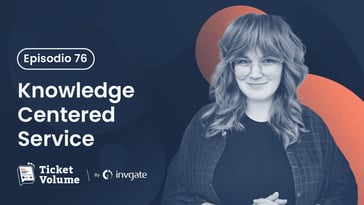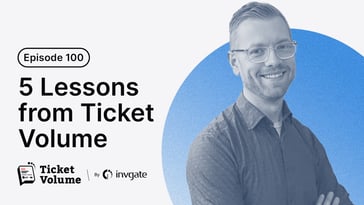The process of building and maintaining an IT Service Management (ITSM) project looks different for every organization. There is however something that all robust initiatives have in common; they combine and adapt different concepts and frameworks within teams to maximize value and operation maturity.
The benefits of this approach are clear. You get to tailor your ITSM project through multiple perspectives that can help achieve different aspects of your goals. At the same time, the process can become a little bit overwhelming if there’s too many concepts or terminology going around that’s not being put to good use.
Luckily, to help you with this, for March’s Ticket Volume webinar, we explored how to make a multidisciplinary ITSM project work. Joining our host, Matt Beran, Jyoti Chopra and Darrel Popowich shared their experiences on how to introduce and combine different frameworks effectively and what common aspects can make ITSM projects fail.
Keep reading for a summary of the episode’s main points. And, to get information on future live webinars, topics, and guests - register here!
So, without further ado, let’s dig in.
Download IT service frameworks cheat sheet
During the webinar we shared with the attendees an ITSM frameworks cheat sheet, that includes 14 frameworks, their scope of action, and use cases.
How to combine frameworks within ITSM projects
When it comes to building a robust ITSM project, the bottom line is that frameworks should get people to act together in a particular fashion. For this, it’s essential to get buy-in from teams and address resistance to change. Different frameworks and management methods attack different problems in a different way, and the goal is to be able to integrate them into the organization’s processes efficiently.
In this sense, both guests are BRM (Business Relationships Management) experts, and brought it up as a powerful tool when it comes to managing projects and combining different methodologies within your project.
For Jyoti, the perfect mix is to bring together ITSM frameworks and BRM; while the first adopts a customer focus and addresses processes such as Incident Management and Change Management, the second brings in communication and transparency and helps to integrate the previous processes successfully within your ITSM project.

When choosing which framework to use, she argued that the pick will depend on each organization’s specific needs and goals. However, Jyoti advised leaders to be mindful of this decision, as it will define your project’s culture and have a big impact on your team’s morale. So, it’s fundamental to experiment, try, ask for feedback, and learn from your mistakes.
Darrel, on his side, also highlighted BRM as the overarching framework for organizing and integrating the rest. Whichever methodologies you choose to combine, he argued, you need to bring in this guiding principle that connects the rest and that is making sure that everything and everyone is working towards the same goal of delivering value. In BRM terminology, this would be “Is this on or off value?”
|
|
"BRM is that top concept, that top framework, the one ring to rule them all, if you will. And why. Bringing in a PMO, and you can choose whichever PMO discipline. They are focused on delivering projects. Bring IT Service Management, it’s focused on incidents and requests and getting consistency around it. You bring in any of the cybersecurity, and they are focused on the attack vectors. And all of those are focused on the doing and the activities inside the organization. Where Business Relationship Management is ensuring that the relationships inside those frameworks, pick whichever one you have, Agile, etc. they get so fixated on inside, they are not connecting as a discipline to the value at the top level of the organization." Darrel Popowich |
Before moving on, we didn’t want to miss out on the chance to mention that David Tomlinson, Senior Learning Specialist and DevOps Ambassador at QA Ltd, came on the pod earlier this month to discuss how to make different frameworks work successfully together for your organization. The valuable insights he shared on the episode can help you further explore these topics!
What makes ITSM projects fail?

Now that we have explored some fundamental strategies to make them work, it’s time to flip the coin and explore what are some of the common denominators that make different ITSM projects and framework implementations fail.
Jyoti was the first to give an answer to this, and for her the big deal breaker is transparent communication and building strong relationships within teams. In this sense, and particularly when difficulties might arise, if there isn’t solid teamwork in place things are much more likely to fall apart.
|
|
"What does not work is not building relationships. So, if you’re not building relationships it will fail. I’m not saying it’s easy, it’s challenging, you’re connecting with people. (...) But you need to learn from conflicts. Not learning from conflicts and moving forward will not work. Apart from relationships, what can cause a failure is not having open communications. So, not having open communication, not having transparency, being it good news or bad news, you need to share everything. I think those things are very critical." Jyoti Chopra |
Also, Jyoti argued that ITSM projects should focus not so much on the solution, or on trying to impose a magic formula for success, but rather on the problem and understanding where it comes from.
Taking from this, Darrel makes the point that a drawback he has often encountered in projects is that teams don’t thoroughly analyze what is making your processes fail or not work optimally. For him, these problems are always people-related before anything else.
In this sense, Darrel pointed out that “if you have a culture where you are holding people to process execution, at the sake of accomplishing something together, it doesn’t matter what framework you bring in, you are going to have people holding them accountable to not delivering on process”.
How to stay relevant in your work environment?
Bringing the webinar to an end, both guests shared advice on how to stay relevant in the workplace. The strategies were oriented to both leaders and all individual contributors looking to ensure they remain valuable and competitive.
Here are the top guidelines that were brought up:
- Foster continuous learning: To keep your game up, it’s fundamental to constantly educate yourself. This involves remaining curious and open, experimenting with new principles and tools, and, most importantly, not letting the fear of failure intercede with this.
- Focus on the newest framework: Related to the previous point, when new frameworks or technologies start gaining traction, you have to make sure you are updated with it and with how it could (if it is the case) potentially integrate with your particular operations. A perfect example of this outside of frameworks is Artificial Intelligence (AI).
- Share knowledge across teams: Also in relation to knowledge, the guests pointed out the importance of sharing across not only teams, but also actress departments in the organization. So the process goes both ways: communicating with others how you are doing things, and learning from them at the same time.
- Build your network: Networking is a key practice to stay relevant in your work environment. It helps to foster professional relationships, facilitates collaboration, and opens up opportunities for growth and advancement.
- Be human first: This one is particularly important when it comes to frameworks and best practices; remember that nothing is written in stone and that you should constantly be assessing and questioning your current processes in order to make use of your common sense and adapt.
- Don’t over focus on tools: Finally, and coming back to problems over solutions, don’t dive head first into tools and expect them to solve all your weaknesses. As was discussed before, you should think long and critically about what is going wrong before coming up with ways to solve it.
Final thoughts
And that’s it for today! Here we went through some of the main points to consider when building a robust ITSM project, from best practices and frameworks, to the do’s and don'ts, and strategies to remain relevant in today's work environment.
If you want to explore the topic even further, don’t miss the chance to listen to the full webinar on platforms like Apple Podcasts, Spotify, YouTube, or your favorite podcast platform.
And there is much more to come. Every month Ticket Volume will be hosting a live webinar on relevant industry matters. Register here to get notified of new dates and topics!















